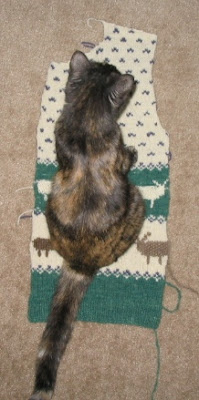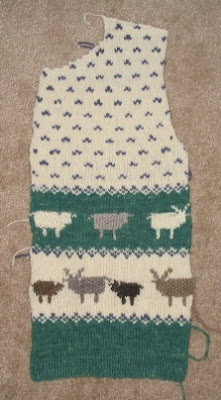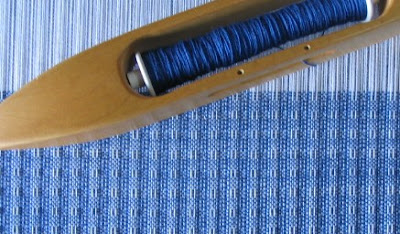By
LeighAfter several days of feeling exceptionally unproductive, it feels so good to be weaving again.
After enjoying the
Online Guild's Lace Weaves Workshop so much, I decided to start again at the beginning and spend some time on each lace structure, exploring to my hearts content. In addition to my workshop notes, I acquired 3 new books:
Lace and Lacey Weaves by Mary E. Snyder,
The Best of Weaver's Huck Lace, edited by Madelyn van der Hoogt, and
The Key to Weaving by Mary E. Black. Plus I have Helene Bress's
The Weaving Book, which has an entire chapter on huck, and this is where I wanted to start.
Today I was finally able to start weaving my first huck towel, and at the moment this is where it stands:

I put on 5 yards of white 8/2 cotton for the warp and am using the same weight in royal blue weft for the weft. My sett is 20 ends per inch.
The threading is simple and should have been no problem:
4 4 4 4 4 4
3 3 3 3
2 2 2 2 2 2
1 1 1 1 1 1 1 1 1
Etc., with plain weave selvedges.
However, I kept losing and misplacing warp ends, don't ask me how! First, I discovered two of them hanging loosely off the warp beam while I was in the middle of sleying. Fortunately I didn't have to rethread the whole thing, I just worked from where the mistakes were to the edges.
Then after I finally got the warp sleyed, I discovered that I had an odd number of ends. I should have had 360, but I counted and recounted only 359. I never did figure out where that missing one got too, it's probably wrapped around the warp beam somewhere. Since I never could find it, I measured off another 5+ yard thread, weighted it with a film canister filled with fishing weights, and tied it on.
Feeling confident that everything was under control, I knotted my warp bundles and started lashing them onto the front apron rod. I tensioned it and was ready to weave the header when I realized that one lone warp end wasn't behaving like the rest. It was popping up off the nice neat plane the rest of the warp made. A quick investigation revealed that somehow this one had missed the heddle altogether. OK. I figured I only had to untie up to that spot and shift everything over by one heddle. Fortunately that didn't take too long.
Now fast forward to where I gotten to before and start weaving the header. Drat, now I discover that 2 warp ends are crossed at the heddles. Hmm. What's the easiest way out of this one. I wasn't in the mood to unlash and untie anything again, so I cut them, pulled them out, uncrossed them, rethreaded, resleyed, and fastened them down with a T-pin.
All this has taken place over several days, as I always have to stop and study any given problem. I am slow to think it through.
One of the reasons I wanted to start with huck is because it is so relaxing to weave. The threading is quick and the weaving rhythm develops easily. I figured with the Computer Design Workshop in full swing, this would offer a creative, productive distraction which wouldn't require intense concentration. Well, hopefully that's where I am now. Relaxed. Creative. Productive. Time will tell.
Related Posts:
Lace Sampler - HuckHuck Towels 2Huck Towels 3Another Warp for HuckFinishing Up the Huck (For Now)Huck Dishtowels Finished
 The roving showed lovely subtle variations of medium gray fibers, beautifully prepared.
The roving showed lovely subtle variations of medium gray fibers, beautifully prepared. Fiber length - about 8 inches
Fiber length - about 8 inches
 I don't have a project in mind for this yet. I think I'll wait until I get the other samples spun.
I don't have a project in mind for this yet. I think I'll wait until I get the other samples spun.






























